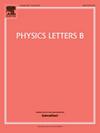Gravitational wave emission in binary neutron star early post-merger within a dark environment
IF 4.5
2区 物理与天体物理
Q1 ASTRONOMY & ASTROPHYSICS
引用次数: 0
Abstract
Using an effective Lagrangian model inspired by Takami et al. [1] we qualitatively study the early post-merger of a nearly symmetric binary Neutron Star (BNS) merger event with a non-vanishing ambient fraction of dark matter. For this we first mimic the dynamics of two oscillating Neutron Star (NS) masses in the gravitational potential well as they merge. We parametrize the dynamics and ejecta properties in the coalescence event allowing the formation of a surrounding debris disk that may be containing a non-vanishing dark matter fraction. In order to analyze the possible novel dark contribution, we start from a dark-matter free modelization as a benchmark. Using Monte Carlo Markov Chain (MCMC) techniques we approximately recover the gravitational waveforms, restricted to early post-merger time interval from existing simulations in the CoRe database. Later, we explore the impact of an additional dark viscous fluid under a prescribed velocity dependent force in the Lagrangian and obtain the resulting waveforms and some spectral features originating in the first few ms in the BNS post-merger. Finally we discuss our qualitative findings and its range of validity in light of the prospects of detectability in present or future experimental settings.
双中子星合并后早期在黑暗环境中的引力波发射
利用受Takami等人启发的有效拉格朗日模型,我们定性地研究了具有不消失的环境部分暗物质的近对称双中子星(BNS)合并事件的早期合并后。为此,我们首先模拟了两个振荡中子星(NS)质量在引力势以及它们合并时的动力学。我们在合并事件中参数化了动力学和喷射特性,允许形成周围可能包含不消失的暗物质部分的碎片盘。为了分析可能的新暗物质贡献,我们从一个无暗物质模型作为基准。利用蒙特卡罗马尔可夫链(MCMC)技术,我们从CoRe数据库中现有的模拟中近似地恢复了重力波形,限制在合并后的早期时间间隔内。随后,我们在拉格朗日量中探讨了在规定的速度依赖力作用下额外的暗粘性流体的影响,并获得了合并后BNS中最初几毫秒的波形和一些频谱特征。最后,我们讨论了我们的定性研究结果及其范围的有效性在目前或未来的实验设置可检测性的前景。
本文章由计算机程序翻译,如有差异,请以英文原文为准。
求助全文
约1分钟内获得全文
求助全文
来源期刊

Physics Letters B
物理-物理:综合
CiteScore
9.10
自引率
6.80%
发文量
647
审稿时长
3 months
期刊介绍:
Physics Letters B ensures the rapid publication of important new results in particle physics, nuclear physics and cosmology. Specialized editors are responsible for contributions in experimental nuclear physics, theoretical nuclear physics, experimental high-energy physics, theoretical high-energy physics, and astrophysics.
 求助内容:
求助内容: 应助结果提醒方式:
应助结果提醒方式:


